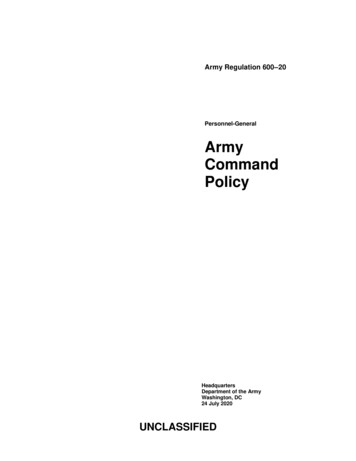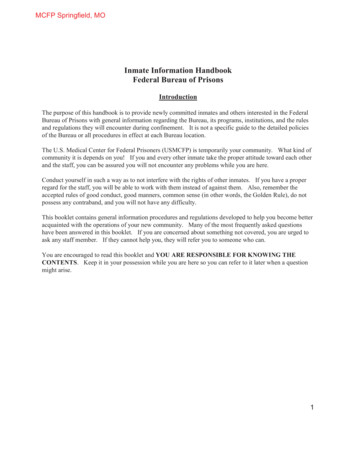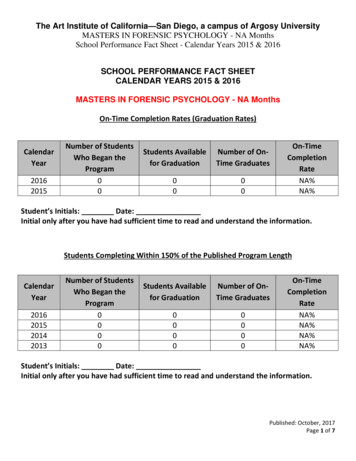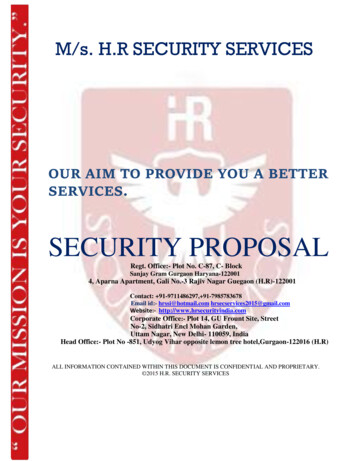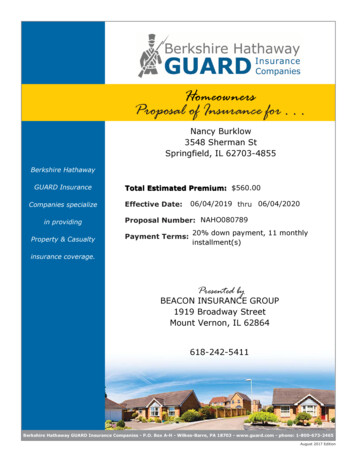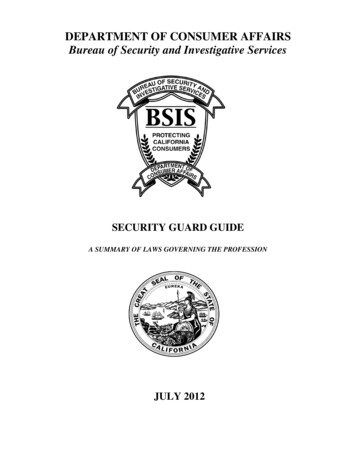
Transcription
DEPARTMENT OF CONSUMER AFFAIRSBureau of Security and Investigative ServicesSECURITY GUARD GUIDEA SUMMARY OF LAWS GOVERNING THE PROFESSIONJULY 2012
SECURITY GUARD GUIDETABLE OF CONTENTSIntroduction . 3A Security Guard’s Role and Responsibilities . 3Power to Arrest and Training Requirements. 4Firearms. 7Authority to Carry an Exposed Firearm. 8Exemptions from the Private Security Services Act . 9Peace Officer Exemptions. . 10Batons . 14Tear Gas. 16Uniforms, Patches, Badges and Vehicles. . 18The sections in the California Penal Code that refer to “Control of Deadly Weapons” have beenrecodified “without substantive changes” (renumbered). The new section numbers became operativeJanuary 1, 2012 and are now mainly found in Part 6 of the Penal Code, beginning at Section 16000.The Security Guard Guide contains references to California Penal Codes as they relate to securityguards and weapons. Corrections have been made to Security Guard Guide to bring it into compliancewith the new section numbers.2
SECURITY GUARD GUIDEINTRODUCTIONA Summary of Laws Governing the ProfessionTerrorism awareness and crime prevention have become major issues in our society. Securityguards play a crucial role in safety and security. A great burden is placed on public forces torespond to crisis situations. As a result, the consumer is turning to the private securityindustry to help protect neighborhoods and businesses.The Department of Consumer Affairs (DCA or Department), Bureau of Security andInvestigative Services (BSIS or Bureau), has jurisdiction over the private security industry.The authority is derived from Division 3, commencing with Section 7580 thru Section 7588.5,Chapter 11.5, Private Security Services Act in the Business and Professions Code (B & P).This brochure explains key sections of the Business and Professions Code (B & P), Penal Code(PC) and California Code of Regulations (CCR), so security guards and law enforcementofficers can be fully informed of the provisions affecting private security guards.Security guards outnumber sworn peace officers four to one in this state, so it benefits peaceofficers and security guards alike to learn and understand the laws governing the securityindustry.NOTE: Every effort has been made to ensure the accuracy of this compilation. Should any confusionor error occur, the law will take precedence. Please refer to the relevant legal codes for clarification.A SECURITY GUARD’S ROLE AND RESPONSIBILITIES A security guard’s role should be to PROTECT people and/or the property of his/heremployer or contracted clients. A security guard’s responsibility BEFORE an incident/offense has occurred should bePREVENTION. A security guard’s responsibility during or after an incident/offense should be toOBSERVE and REPORT. The security guard’s role and responsibilities listed in the security guard guide are atthe discretion of the employer. Some employers may want their security personnel tobe more proactive as long as they stay within the parameters of what is lawfulregarding private person (citizen’s) arrest.3
SECURITY GUARD GUIDESECURITY GUARD POWER TO ARRESTANDTRAINING REQUIREMENTSA security guard must complete 40 hours of required training and an 8-hour refresher courseevery 12 months after completing the 40-hour course. As part of that training, a securityguard must complete an 8-hour Power to Arrest/Weapons of Mass Destruction TerrorismAwareness training course prior to submitting an application. In addition, 16 hours oftraining is required within the first 30 days of receiving a security guard registration, orwithin the first 30 days from the date of hire as a security guard. An additional 16 hours oftraining is also required within the first six months after receiving a security guardregistration, or within the first six months of employment as a security guard.Date of CompletionPrior to submission of an application for asecurity guard registrationTraining Required within the first 30 Daysafter receipt of registration or date of hire.Training Required within the First SixMonths after receipt of registration or dateof hire.TOTAL HOURSAnnual Continuing Education Requiredafter first year of licensureTraining Hours Needed8 hours (4 hours of Powers to Arrest/4 hoursWeapons of Mass Destruction /TerrorismAwareness Training16 Hours (8 hours mandatory courses/8 hoursof elective courses from training syllabus)16 Hours (8 hours mandatory courses/8 hoursof elective courses from training syllabus)40 HOURS8 Hours AnnuallyA brief course of study in these laws and procedures is required prior to application for a“guard card.” The following code sections describe the requirements in detail.DIVISION 3, CHAPTER 11.5, PRIVATE SECURITY SERVICESARTICLE 4Business and Professions Code Section 7583.6 (Excerpt)(a) A person entering the employ of a licensee to perform the functions of a security guard ora security patrolperson shall complete a course in the exercise of the power to arrest prior tobeing assigned to a duty location.(b) Except for a registrant who has completed the course of training required by Section7583.45, a person registered pursuant to this chapter shall complete not less than 32 hours oftraining in security officer skills within six months from the date the registration card is4
SECURITY GUARD GUIDEissued. Sixteen of the 32 hours shall be completed within 30 days from the date theregistration card is issued.(c) A course provider shall issue a certificate to a security guard upon satisfactory completionof a required course, conducted in accordance with the department's requirements. A privatepatrol operator may provide training programs and courses in addition to the trainingrequired in this section. A registrant who is unable to provide his or her employing licenseethe certificate of satisfactory completion required by this subdivision shall complete 16 hoursof the training required by subdivision (b) within 30 days of the date of his employment andshall complete the 16 remaining hours within six months of his or her employment date.[Emphasis added](d) The department shall develop and approve by regulation a standard course andcurriculum for the skills training required by subdivision (b) to promote and protect thesafety of persons and the security of property. For this purpose, the department shall consultwith consumers, labor organizations representing private security officers, private patroloperators, educators, and subject matter experts.(e) The course of training required by subdivision (b) may be administered, tested, andcertified by any licensee, or by any organization or school approved by the department. Thedepartment may approve any person or school to teach the course.(f) (1) On and after January 1, 2005, a licensee shall annually provide each employeeregistered pursuant to this chapter with eight hours of specifically dedicated review orpractice of security officer skills prescribed in either course required in Section 7583.6 or7583.7.Business and Professions Code Section 7583.7 (Excerpt)(a) The course of training in the exercise of the power to arrest may be administered, tested,and certified by any licensee or by any organization or school approved by thedepartment. The department may approve any person or school to teach the course in theexercise of the power to arrest. The course of training shall be approximately eight hours inlength and shall cover the following topics:(1) Responsibilities and ethics in citizen arrest.(2) Relationship between a security guard and a peace officer in making an arrest.(3) Limitations on security guard power to arrest.(4) Restrictions on searches and seizures.(5) Criminal and civil liabilities.(A) Personal liability.(B) Employer liability.(6) Trespass law.(7) Ethics and communications.(8) Emergency response, including response to medical emergencies.(9) Security officer safety.5
SECURITY GUARD GUIDE(10) Any other topic deemed appropriate by the bureau.(b) The majority of the course shall be taught by means of verbal instruction. This instructionmay include the use of a video presentation.Business and Professions Code Section 7583.8 (Excerpt)No employee of a licensee who performs the function of a security guard or securitypatrolperson shall be issued a registration card until there is proper certification by theinstructor that the exercise of the power to arrest course has been taught and the employee'scertification that the instruction was received has been delivered to the department.CALIFORNIA CODE OF REGULATIONSTITLE 16, DIVISION 7ARTICLE 6§628. Training in Exercising the Powers to Arrest.(a) The course of training in the powers to arrest prescribed by the Department of ConsumerAffairs pursuant to Sections 7583.6(a) and 7583.7(a) of the Business and Professions Codeconsists of successful completion of a course approved by the bureau in exercising thepowers to arrest.(b) Uniformed employees of private patrol operators and responding alarm agents shall takeand successfully complete the training course and examination in the exercise of powers toarrest. An employee must receive a score of 100% on said examination in order tosuccessfully complete said course.The course of training and administration of the examination may be given by a trainingschool approved by the bureau or by the employer or such uniformed employees providedthat such employer has a designated instructor and such instructor is knowledgeable in thepowers to arrest as set forth in the Standard Training Manual issued by the bureau and isable to assist employees who cannot read or write.(c) A licensee or approved training school which administers the training and examinationshall retain the examination results on bureau-approved answer sheets for a period of notless than two years or until audited by the bureau, whichever occurs first. A licensee ortraining facility shall certify under penalty of perjury on the employee’s application forregistration that such person has successfully completed the training and examinationcontained in the Standard Training Manual issued by the bureau.(d) No employee may be assigned to work until he or she has completed the course referredto in subsection (a).6
SECURITY GUARD GUIDEFIREARMSTraining and background checks are required in order to become registered as and armedsecurity guard. The following regulations discuss training requirements, distinctionsbetween exposed and concealed firearms, and firearm-related crimes.CALIFORNIA CODE OF REGULATIONSTITLE 16, DIVISION 7ARTICLE 7§631. Requirements for Carrying or Use of Firearms or Simulated Firearms.(a) A registered employee shall not carry, use or possess a loaded or unloaded firearm in theperformance of his duty, whether or not it is serviceable or operative, unless he has in hispossession a firearms qualification card issued to him by the chief. Such card must be shownto any peace officer or bureau representative upon demand.(b) A registered employee may not carry any replica or other simulated firearm.631.1. Allowing the Carrying or Use of a Firearm.(a) A private patrol or alarm company operator shall not allow an employee to carry oruse a loaded or unloaded firearm, whether or not it is serviceable or operative, unless suchemployee possesses a firearms qualification card.(b) A private patrol or alarm company operator may not allow an employee to carry anyreplica or other simulated firearm.632. Firearms Qualification Card.(a) The bureau shall issue a firearms qualification card to an applicant where all of thefollowing conditions exist:(1) The applicant is a licensed private investigator, alarm company operator, private patroloperator or registered employee of such a licensee or is employed or compensated by alawful business or public agency as a security guard or patrol person;(2) The applicant has filed with the bureau a completed application for a firearmsqualification card on a form prescribed by the bureau, dated and signed by the applicantunder penalty of perjury that the information in the application is true and correct;(3) The application is accompanied by:(A) Payment of the firearms qualification fee prescribed by Section 640(g).7
SECURITY GUARD GUIDE(B) Proof, satisfactory to the bureau, of successful completion of a course approved by thebureau in the carrying and use of a firearm. Including:1. Proof of successful passage of a written examination prescribed by the bureau. Suchexamination shall be based on information required to be taught pursuant to Section 635; and2. Proof of qualifying on an approved firearm range with the caliber of weapon to be used bythe applicant pursuant to Section 635.(4) The bureau has determined, after investigation, that the carrying and use of a firearm bythe applicant in the course of his or her duties presents no apparent threat to the publicsafety.(b) The firearms qualification card, when issued, shall be mailed to the applicant at theaddress which appears on the application. In the event of the loss or destruction of the cardthe cardholder may apply to the chief for a certified replacement for the card, stating thecircumstances surrounding the loss, and pay a 10 certification fee whereupon the chief shallissue a certified replacement for such card.(c) Firearms qualification card does not authorize the holder thereof to carry a concealedweapon as that term is defined in Penal Code Section 26150.AUTHORITY TO CARRY AN EXPOSED FIREARMThe Business and Professions Code and the Penal Code contain several sections that securityguards must obey when they carry an exposed firearm on duty.BUSINESS AND PROFESSIONS CODEDIVISION 3, CHAPTER 11.5, PRIVATE SECURITY SERVICESARTICLE 4Business & Professions Code Section 7583.5(a) Every licensee and any person employed and compensated by a licensee, other lawfulbusiness or public agency as a security guard or patrolperson, and who in the course of thatemployment or business carries a firearm, shall complete a course of training in the exerciseof the powers to arrest and a course of training in the carrying and use of firearms. Thissubdivision shall not apply to armored vehicle guards hired prior to January 1, 1977.Armored vehicle guards hired on or after January 1, 1977, shall complete a course in thecarrying and use of firearms, but shall not be required to complete a course of training in theexercise of the powers to arrest. The course of training in the carrying and use of firearmsshall not be required of any employee who is not required or permitted by a licensee to carryor use firearms. The course in the carrying and use of firearms and the course of training inthe exercise of the powers to arrest shall meet the standards which shall be prescribed by theDepartment of Consumer Affairs. The Department shall encourage restraint and caution inthe use of firearms.8
SECURITY GUARD GUIDE(b) No uniformed employee of a licensee shall carry or use any firearm unless the employeehas in his or her possession a valid firearm qualification card.Note: It is illegal for a licensee or registrant to carry a concealed weapon on duty without a permitissued by local authorities. The firearm permit issued by BSIS only allows the security guard to carryan exposed firearm while on duty.EXEMPTIONS FROM THE PRIVATE SECURITY SERVICES ACTBusiness & Professions Code Section 7582.2 (Excerpt)This chapter [Chapter 11.5, the Private Security Services Act] does not apply to the following:(a) A person who does not meet the requirements to be a proprietary private security officer,as defined in Section 7574.1, and is employed exclusively and regularly by any employer whodoes not provide contract security services for other entities or persons, in connection withthe affairs of the employer only and where there exists an employer-employee relationship ifthat person at no time carries or uses any deadly weapon in the performance of his or herduties. For purposes of this subdivision, "deadly weapon" is defined to include anyinstrument or weapon of the kind commonly known as a blackjack, slungshot, billy,sandclub, sandbag, metal knuckles, any dirk, dagger, pistol, revolver, or any other firearm,any knife having a blade longer than five inches, any razor with an unguarded blade and anymetal pipe or bar used or intended to be used as a club. (k) A peace officer of this state or a political subdivision thereof while the peace officer isemployed by a private employer to engage in off-duty employment in accordance withSection 1126 of the Government Code. However, nothing herein shall exempt a peace officerwho either contracts for his or her services or the services of others as a private patroloperator or contracts for his or her services as or is employed as an armed private securityofficer. For the purpose of this subdivision, “armed security officer” means an individualwho carries or uses a firearm in the course and scope of that contract or employment.(l) A retired peace officer of the state or political subdivision thereof when the retired peaceofficer is employed by a private employer in employment approved by the chief lawenforcement officer of the jurisdiction where the employment takes place, provided that theretired officer is in a uniform of a public law enforcement agency, has registered with thebureau on a form approved by the director, and has met any training requirements or theirequivalent as established for security personnel under Section 7583.5. This officer may notcarry an unloaded and exposed handgun unless he or she is exempted under the provisionsof Article 2 (commencing with Section 26361) of Chapter 6 of Division 5 of Title 4 of Part 6 ofthe Penal Code, and may not carry a loaded or concealed firearm unless he or she isexempted under the provisions of Article 2 (commencing with Section 25450) of Chapter 2 ofDivision 5 of Title 4 of Part 6 of the Penal Code or Sections 25900 to 25910, inclusive, of thePenal Code or has met the requirements set forth in subdivision (d) of Section 26030 of the9
SECURITY GUARD GUIDEPenal Code. However, nothing herein shall exempt the retired peace officer who contracts forhis or her services or the services of others as a private patrol operator.PEACE OFFICER EXEMPTIONSAn active duty peace officer or a level 1 or 2 reserve peace officer may apply to be an armedor unarmed security guard. However, to carry a weapon as a security guard, a peace officermust have on his/her person, while performing the duties of a security guard, either awritten authorization from his/her primary employer (law enforcement entity) giving thepeace officer permission to carry a weapon while performing the duties of a security guard orthe peace officer must have an exposed firearm permit issued by the Bureau. If the peaceoffice is unable to obtain the written permission from his/her primary employer (lawenforcement entity) the peace officer must apply for the firearm permit.Most law enforcement entities will not give a peace officer written permission on theirdepartment letterhead to carry a weapon, off duty, while performing the duties of a securityguard. Therefore, the peace office must usually apply for the exposed firearm permit.An active duty and level 1 & 2 reserve peace officer is also exempt from having to submitfingerprints for the security guard registration. However, a peace officer must submitfingerprints if the officer is also applying for the firearm permit. If the peace officer is onlyapplying for the security guard registration they have the option of submitting or notsubmitting fingerprints. However, if they leave their primary employment with lawenforcement (retired, quit, laid off, or fired) and have not submitted fingerprints they mustnotify the Bureau that they are no longer with law enforcement and return the security guardregistration to the Bureau within 72 hours. If they wished to continuing working as asecurity guard they would have to reapply as a private citizen and complete the requiredtraining along with submission of fingerprints in order to obtain a security guardregistration.Most peace officers, who work off duty as armed or unarmed security guards, prefer tosubmit finger prints for both the security guard and the firearm permit. This allows a peaceofficer to retain the security guard registration and exposed firearm permit after the peaceofficer retires or changes employment status, and is no longer a sworn peace officer.APPLICABLE PENAL CODE SECTIONS(FROM THE 2012 COMPACT EDITION)I.Penal Code Section 25850 [Carrying of loaded firearms; misdemeanor]§25850. (a) A person is guilty of carrying a loaded firearm when the person carries a loadedfirearm on the person or in a vehicle while in any public place or on any public street in anincorporated city or in any public place or on any public street in a prohibited area ofunincorporated territory.10
SECURITY GUARD GUIDE(b) In order to determine whether or not a firearm is loaded for the purpose of enforcing thissection, peace officers are authorized to examine any firearm carried by anyone on the personor in a vehicle while in any public place or on any public street in an incorporated city orprohibited area of an unincorporated territory. Refusal to allow a peace officer to inspect afirearm pursuant to this section constitutes probable cause for arrest for violation of thissection.(c) Carrying a loaded firearm in violation of this section is punishable, as follows:(1) Where the person previously has been convicted of any felony, or of any crime madepunishable by a provision listed in Section 16580, as a felony.(2) Where the firearm is stolen and the person knew or had reasonable cause to believe that itwas stolen, as a felony.(3) Where the person is an active participant in a criminal street gang, as defined insubdivision (a) of Section 186.22, under the Street Terrorism Enforcement and Prevention Act(Chapter 11 (commencing with Section 186.20) of Title 7 of Part 1), as a felony.(4) Where the person is not in lawful possession of the firearm, or is within a class of personsprohibited from possessing or acquiring a firearm pursuant to Chapter 2 commencing withSection 29800) or Chapter 3 (commencing with Section 29900) of Division 9 of this title, orSection 8100 or 8103 of the Welfare and Institutions Code, as a felony.(5) Where the person has been convicted of a crime against a person or property, or of anarcotics or dangerous drug violation, by imprisonment pursuant to subdivision (h) ofSection 1170, or by imprisonment in a county jail not to exceed one year, by a fine not toexceed one thousand dollars ( 1,000), or by both that imprisonment and fine.(6) Where the person is not listed with the Department of Justice pursuant to Section 11106 asthe registered owner of the handgun, by imprisonment pursuant to subdivision (h) of Section1170, or by imprisonment in a county jail not to exceed one year, or by a fine not to exceedone thousand dollars ( 1,000), or both that fine and imprisonment.(7) In all cases other than those specified in paragraphs (1) to (6), inclusive, as amisdemeanor, punishable by imprisonment in a county jail not to exceed one year, by a finenot to exceed one thousand dollars ( 1,000), or by both that imprisonment and fine.(d) (1) Every person convicted under this section who has previously been convicted of anoffense enumerated in Section 23515, or of any crime made punishable under a provisionlisted in Section 16580, shall serve a term of at least three months in a county jail, or, ifgranted probation or if the execution or imposition of sentence is suspended, it shall be acondition thereof that the person be imprisoned for a period of at least three months.11
SECURITY GUARD GUIDE(2) The court shall apply the three-month minimum sentence except in unusual cases wherethe interests of justice would best be served by granting probation or suspending theimposition or execution of sentence without the minimum imprisonment required in thissection or by granting probation or suspending the imposition or execution of sentence withconditions other than those set forth in this section, in which case, the court shall specify onthe record and shall enter on the minutes the circumstances indicating that the interests ofjustice would best be served by that disposition.(e) A violation of this section that is punished by imprisonment in a county jail not exceedingone year shall not constitute a conviction of a crime punishable by imprisonment for a termexceeding one year for the purposes of determining federal firearms eligibility under Section922(g)(1) of Title 18 of the United States Code.(f) Nothing in this section, or in Article 3 (commencing with Section 25900) or Article 4(commencing with Section 26000), shall preclude prosecution under Chapter 2 (commencingwith Section 29800) or Chapter 3 (commencing with Section 29900) of Division 9 of this title,Section 8100 or 8103 of the Welfare and Institutions Code, or any other law with a greaterpenalty than this section.(g) Notwithstanding paragraphs (2) and (3) of subdivision (a) of Section 836, a peace officermay make an arrest without a warrant:(1) When the person arrested has violated this section, although not in the officer's presence.(2) Whenever the officer has reasonable cause to believe that the person to be arrested hasviolated this section, whether or not this section has, in fact, been violated.(h) A peace officer may arrest a person for a violation of paragraph (6) of subdivision (c), ifthe peace officer has probable cause to believe that the person is carrying a handgun inviolation of this section and that person is not listed with the Department of Justice pursuantto paragraph (1) of subdivision (c) of Section 11106 as the registered owner of that handgun.Note: Merely completing a course in firearms training does not authorize a security guard to carry afirearm on duty. A security guard MUST obtain a firearm permit in order to carry a firearm while onduty. A security guard who carries a firearm on duty without a valid permit could be arrested andconvicted for violation of Section 25850 of the Penal Code.II. Penal Code Section 25400 [Carrying a weapon concealed within a vehicle or on person]§25400. (a) A person is guilty of carrying a concealed firearm when the person does any ofthe following:(1) Carries concealed within any vehicle that is under the person's control or direction anypistol, revolver, or other firearm capable of being concealed upon the person.12
SECURITY GUARD GUIDE(2) Carries concealed upon the person any pistol, revolver, or other firearm capable of beingconcealed upon the person.(3) Causes to be carried concealed within any vehicle in which the person is an occupant anypistol, revolver, or other firearm capable of being concealed upon the person.(b) A firearm carried openly in a belt holster is not concealed within the meaning of thissection.(c) Carrying a concealed firearm in violation of this section is punishable as follows:(1) If the person previously has been convicted of any felony, or of any crime madepunishable by a provision listed in Section 16580, as a felony.(2) If the firearm is stolen and the person knew or had reasonable cause to believe that it wasstolen, as a felony.(3) If the person is an active participant in a criminal street gang, as defined in subdivision (a)of Section 186.22, under the Street Terrorism Enforcement and Prevention Act (Chapter 11,commencing with Section 186.20) of Title 7 of Part 1), as a felony.(4) If the person is not in lawful possession of the firearm or the person is within a class ofpersons prohibited from possessing or acquiring a firearm pursuant to Chapter 2commencing with Section 29800) or Chapter 3 (commencing with Section 29900) of Division 9of this title, or Section 8100 or 8103 of the Welfare and Institutions Code, as a felony.(5) If the person has been convicted of a crime against a person or property, or of a narcoticsor dangerous drug violation, by imprisonment pursuant to subdivision (h) of Section 1170, orby imprisonment in a county jail not to exceed one year, by a fine not to exceed one thousanddollars ( 1,000), or by both that imprisonment and fine.(6) If both of the following conditions are met, by imprisonment pursuant to subdivision (h)of Section 1170, or by imprisonment in a county jail not to exceed one year, by a fine not toexceed one thousand dollars ( 1,000), or by both that fine and imprisonment:(A) The pistol, revolver, or other firearm capable of being concealed upon the person isloaded, or both it and the unexpended ammunition capable of being discharged from it are inthe immediate possession of the person or readily accessible to that person.(B) The person is not listed with the Department of Justice pursuant to paragraph (1) ofsubdivision (c) of Section 11106 as the registered owner of that pistol, revolver, or otherfirearm capable of being concealed upon the perso
A security guard must complete 40 hours of required training and an 8 -hour refresher course every 12 months after completing the 40-hour course. As part of that training, a security guard must complete an 8-hour Power to Arrest/Weapons of Mass Destruction Terrorism Awareness tra

